|
WHITE COLOR ARTICLES
White By Mrs
Hoyt – The Book of the Poodle 1982
Clear and brilliant, with no cream, yellow, or tan. A glistening, startling white. There are at least two kinds of
white, white 1 and white 2.
The only visible difference between the two is that white 2 is more likely to have pink
skin rather than a bluish black or silver skin. The eyes are jet black, so dark that one hardly can distinguish the iris from
the pupil. Eyerims, nose, and toenails are black. The skin is bluish black or silver, a solid color .
Common Faults:
Such dogs may have a pink skin or a pink skin mottled with black or blue spots. This is a very minor fault and only should
be counted by the judge if a white dog of equal quality with a black or silver skin is in the ring, or against a colored dog,
equally good, with perfect coloring. It should not disturb the breeder .
Such dogs may have white toenails. The same conclusion
applies to this as to the skin color above.
Such dogs may have a partially pink eyerim or one whole pink eyerim, or a
pink spot on the nose or on the lips, with or without pink eyerims. These are major show faults which the breeder must not
ignore, and such dogs should be bred only to a strain carrying very strong black pigment.
Such dogs may have brown
eyes rather than the so-called "dead black." This is a fault in the ring, but the breeder can remedy it by proper breeding.
Such dogs may have a small spot of completely black hair, a show fault if the spot is discovered or is in plain sight.
The famous Champion Broadrun Cherry had such a spot back of his wide, well feathered ear. No effort was made to disguise it,
and no judge ever observed it. We ourselves only discovered it when washing the dog. At any rate, the breeder can overlook
such a fault.
Question: Will white bred to white produce white?
Answer: Not always. Again, we
cannot be sure of the number of genes responsible for white or how they are paired, but if we go by the theory that white
is inherited in a similar manner to brown, we can see why a black or other colored puppy appears in a litter from time to
time from white parents. That is, the parents of such a litter are each a different kind of white and when bred together their
recessive genes which would normally block other colors cannot act. Therefore black puppies can appear. There are probably
other genes that we do not know about involved in these crosses. It is these and the introduction of other color crosses which
produce the mottled skin.
Question: Will breeding black to white improve the white type?
Answer:
Only if there is no other means available and the white is truly inferior in type. As a rule the whites have better coats,
better bone, and equally good temperaments. Some of the continental whites are slightly round in the skull and heavy in muzzle.
Still, I have seen plenty of blacks like this, too.
Question: What is the best color other than white to breed
to white for type?
Answer: Black.
Question: In breeding white to black to improve type, how can one return
safely to white?
Answer: Breed the hybrid offspring of the black and white union to a white-bred white of the same
kind of white as the original white.
Question: Will breeding a white and a black produce gray?
White By
Mrs Hoyt – The Book of the Poodle 1982
Answer: Not unless the white carries the proper modifying genes to produce
gray.
Question: Does breeding white to white finally produce albinos?
Answer: No, not unless one "downgrades"
one's breeding. For instance, breeding a dog with inferior pigment to another relative with poor pigment is downgrading color
pigment. One should never use albinos themselves for breeding. Question: Suppose an albino has perfect type?
Answer:
No matter, do not use it. With time, patience, and intelligence one can acquire an equally good type in a sound and healthy
animal. Deafness and weak eyes frequently accompany albinism.
Question: Are there any colors which should not
be bred to white?
Answer: Whenever white is bred to another color, a risk is taken. Remember that the white
color is caused by two recessive blocking genes in combination with other genes. When white is bred to another color which
does not carry these recessive blocking genes, any color which these may have blocked in the white may come out. For example,
if a white which carries black that is masked by the blocking genes is bred to a brown, very likely the puppies will all be
bad blacks. If such a white is bred to gray the color of your gray is not likely to appear in the puppies. If you are lucky,
you may get a blue, but most likely you will get poorly colored blacks or grays. This is provided that the silver carries
none of the white genes. In that case you may get a white.
Question: Is white popular in the show ring and
with the public?
Answer: It is the best color of all, in my opinion, for show purposes. The dazzling purity
of white arouses sympathy and admiration, and the color contrast of the black eyes and nose is truly beautiful and dramatic.
It is very hard for any color to defeat a good white. On the other hand, white puppies do not sell as well as the darker colored
ones. People feel that they will get dirty too easily and be hard to keep as house pets.
Question: Are there
many white lines and top winning dogs from these lines?
Answer: There certainly are, in all three varieties.
The great winning whites are too numerous to mention. In the 1930's Tri- International Champion Nunsoe Duc de la Terrace of
Blakeen won Best in Show at Westminster. Another Standard, Champion Puttencove Promise, a descendent of Duc, did likewise
in 1958. A white Toy, Champion Wilber White Swan, became the first Toy Dog to win Best in Show at Westminster, in 1956. All
three of these dogs produced many Best in Show winners. All three are behind a great many winners in their varieties. Both
Duc and Promise are behind the excellent white Standard line established by Alekai, which includes many famed winners (see
Alekai Kennel story). And, of course, it is a white Standard bitch that has just become the all-time Top Winning Best in Show
Dog in America, Champion Lou Gin's Kiss Me Kate. There have been many famed white Miniatures, too, from the days of Champion
Blakeen Snow Boy of Fircot down to the present, among them Marguerite Tyson's several magnificent Best in Show winners, those
of Ernest E. Ferguson, and others including the latest to win the West- minster Non-Sporting Group, Mr. Koeppel's Champion
J .L.C.'s Critique. White Toys have been numerous, too, with Champion Blakeen Ding Ding, Champion Peeple's Sahara, and Champion
Ty-Del's Dancing Doll among those coming to mind. Indeed, white Poodles have brought many honors to the breed.
White
By Mrs Hoyt – The Book of the Poodle 1982
_______________________________________________
by DAVID D. WHITNEY University of Nebraska
Well-groomed
white Poodles, with the contrasting colors of their jet-black noses and white coats have been popular in some of the European
countries for a long time and are beginning to be favorites in some sections of this country. There are two kinds: the ivory-whites
with a few apricot-colored hairs in their coats, indicating that they would have been apricots if they had not been white;
and the snow-whites or ice-whites with a few black hairs in their coats, indicating that they would have been black dogs if
they had not been white. Their white color is caused by the activity of a pair of recessive genes, the extremely white piebald
genes which prevent the formation of pigment in the hairs.
Spotting Many amateur
Poodle breeders consider themselves fortunate in having selected solid-colored breeding stocks with which to start their kennels.
They even may boast of their solid-colored puppies but, after a while, one of their puppies may be born with small white spots
on its chest. Its appearance seems a mystery and immediate resolutions are made to destroy it with the hope that there will
be no more born like it. Such hopes are seldom realized !
The white spots
are the result of the activities of recessive genes which have been in the stock in an inactive state, perhaps for many generations,
until in the present mating, when two of them have been inherited by the puppy, one from each parent, forming a pair which
at once begin to prevent the formation of pigment in the hair of small areas on the chest. The other puppies in the litter
were lucky in not receiving a pair of these genes, but probably received one which they may pass on to their offspring for
making white spots in later generations.
Some of the dogs
in other breeds, as Fox Terriers, Collies, Pointers, Cocker Spaniels and others, have larger white areas or spots in
their coats due to another pair of recessive, depigmenting genes. In the white Bull Terrier the white area is so large as
to nearly cover the whole coat (sometimes it does), leaving only a black spot of color on the head or ear. A third pair of
recessive, depigmenting genes, the extremely white piebald genes, cause the large white area to further increase in size so
as to actually cover the entire dog, but leaving a few traces of the original coat color in a few of the hairs, as in many
of the white dogs of other breeds. The nose, eyes, lips and footpads are not affected but retain their original black color
.
Ivory-white Poodles
The white Poodles having traces of apricot colors easily may be identified by placing either the dog or a generous sample
of its hair against a white background of paper or cloth. The ivory tints will be evident at once. There is considerable variation
in the extent and depth of the apricot coloring in the coats. Sometimes it may be a conspicuous biscuit colormg on the ears
or even throughout the entire coat, but in others the traces are practically unnotice- able to an ordinary observer. Some
people state that there also may be pink tints in the coats of some dogs. In many coats the apricot hairs may be readily seen
in direct sunlight or by using a reading glass or in microscopic prepara- tions of hair samples.
Snow-white Poodles
The white Poodles having traces of black hair easily may be identified as ivory-whites by placing them against a white background.
No ivory tints will be seen but their coats will be a cold-white color. Some dogs, however have more traces of black in their
coats than others, and may appear slightly grayish in places or throughout their entire coats. An examination of the coats
in strong sunlight usually will show a few black hairs, or by using a hand lens, or by observing prepared samples of the hair
under a microscope.
Puppies As the
genes for white are recessive, a pair of white Poodles always produce white puppies, which may appear whiter than their parents,
owing to more enclosed minute air globules in their hairs than in adult dogs. When the puppies mature, very few of their new,
small fur hairs contain air globules, resulting in a diminishing of the intense whiteness in their adult coats.
A pair of ivory-whites
will produce ivory-white puppies. A mating of an ivory-white, with an apricot-colored dog will produce all apricot-colored
puppies in various shades of apricot, which are likely to fade readily in the sunlight. A pair of snow-white dogs may produce
either snow-white or ivory-white puppies, depending on whether or not they carry apricot genes in their underlying black color
. The submerged black and apricot in the white dogs may carry as many recessive-color genes as any ordinary black or apricot
dog. No one can predict with any assurance, what the colors of puppies will be when one parent is white and the other one
colored, except in the mating of an ivory- white and an apricot. Two white dogs mated to colored ones have been reported to
have produced not only black, apricot and white but also brown and silver puppies. Blue and the undesirable black-and-tan
genes may be carried by apricots and blacks, so no one should be surprised to see these colors appear from the matings of
some of the whites with colored dogs. As all the genes for the various kinds of white spotting are recessive, a single one
of these genes may be carried in a dormant state for many genera- tions in solid-colored Poodles. But when it meets another
similar gene in a puppy, white areas are developed in the coat. It was reported some years ago, that after 19 successive generations
of black breeding, a pure white (extreme white piebald) puppy was born in a litter of black puppies. At that time it seemed
unexplainable, but with the present knowledge of the laws of in- heritance, such a sudden appearance of a white puppy is no
longer mysterious.
From: This
is the Poodle – Lester H. Martin
by DAVID D. WHITNEY University of Nebraska
| White standard pup at birth |
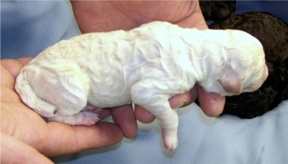
|
| White standard pup at 1 week |

|
| White standard pup at 2 weeks |
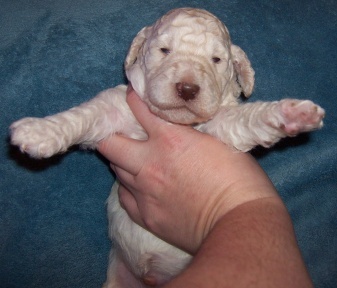
|
| White standard pup at 3 weeks |
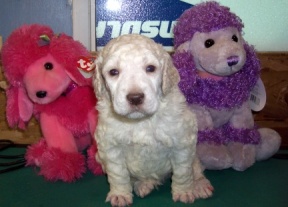
|
| White standard pup at 6 weeks |
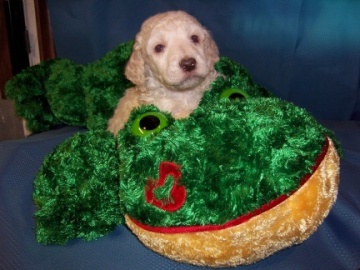
|
| White adult miniature |
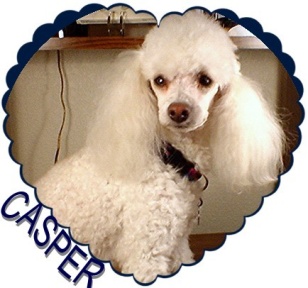
|
COLOR ARTICLES THAT COMPARE WHITE TO CREAM
WHITES AND CREAMS - from an article by Pamela Ingram, Sassafrass Kennels
White has always been a most popular color in the show ring. It is
dazzling. It stands out especially when the group and
best in show awardsare done at dusk. But since every
fault stands out so clearly the white showdog must be
much better than a black.
Whites have improved so tremendously in the past few years that they
area very popular color again with the public, in fact
the Toys than any otherfor a medium priced tiny pet.
Pale creams with their jet black noses anddeep eye rims
and appealing little faces are also eagerly loved.
Actually the color "white" in poodles covers as wide a range as any
othercolor. Granted a white may vary from the white of
fresh snow to a cream sopale it appears to be white.
The great difference in whites occurs not really in the
color of the mature dogs coat as in the color of the pigment. There are whites with black noses and dark skins, whites with brown noses, whites with pink skins and whites with spotted noses or black noses and spotted skins and finally whites with dark and fading noses.
Now the public does not usually expect a jet black nose at six wks.
but they do not like yellow eared whites as they do not
see how they could clear as indeed they do, provided
the ears are more buff or yellow colored than orange.
Many lines of whites are, as puppies, buff colored all over. Some misinformed people call these apricots. Most turn creamy white at maturity.
Now a breeder insists on a black nose at six wks. and justifiably.
There is very little difference on the mature coat color
of a stark white to a pale cream but there may be a much
wider variety in the pigment ( by which Imean nose color,
eye rim color and skin color. )
The Poodle Standard in color reads in part: "White poodles have black
noses, eye rims and lips. Black or self colored toenails
and very dark eyes."
It says nothing of color of skin. I have seen best in show white miniatures
with spotted skin and many with faded noses and these
have become champions. However, most breeders will agree
that a dark skinned snow white with jet black non--fading
pigment is the ultimate aim. Bred together they breed
true.
However, for practical purposes the almost black skinned light creams
which appear white are also excellent---as seldom does
the pigment fade and they almost always have dark skin---furthermore
they can usually be bred to off nosed whites for all
black nosed puppies. Personally I would far rather have
an ecur or milky colored white with great pigment than a stark
white with fading nose or a half pink eye rim. The faint difference of coat is so little compared to the total effect.
Variations of whites at 6 wks. of age:
1. Coat color varies
a. stark white all over
b. stark white with cream ears
c. buff color all over slightly deeper ears
2. Skin color varies
a. blackish skin all over especially stomach and foot pads
b. silver skin is deep pink red and tans to blue when clipped &
sun exposed.
c. spotted skin. Note spots on stomach. Remains spotted throughout
life.
d. pale pink skin---stays pink
3. Nose pigment varies
a. Jet deep black---should not fade.
b. spotted nose---big heavy spots, mostly filled in now, will cover
at 3 mon. and hold.
c. tiny brownish black speckles covering most of nose. Will fade at
maturity.
d. no pigment or very light pigment, no eye rim pigment.
Some people like pink skinned white with black noses and others prefer
dark skinned white with black noses. Either is correct.
White bred to white usually produces white. In my experience
it always breeds true. Only the all over dark skinned
whites with no skin color-break may be bred to color.
Pink skinned and especially spotted skinned whites are dangerous as
the spots may become spotted hair instead of only the
skin.
Unless you really know your line it is safer to stay within your color.
But when you have a white (irrespective of what colors
it came from) you can on my experience, safely breed
it to another white irrespective of it's color background.
When you have your litter of tiny black nosed stark white puppies
with their little fat purple stomachs I can assure you
there is nothing so beautiful. You will never get tired of just looking at them.
GENERAL TIPS ON WHITES
1. To help deepen fading pigment, sunshine, vitamins B & C, top
health.
2. To get pigment in your puppies, chose a black skinned, black nosed
sire ( either white or light cream)
3. Do not breed a spotted skinned white to a darker colored dog.
4. Use ordinary corn starch as a cleansing agent.
5. Keep on white paper or towels.
from an article by Pamela Ingram, Sassafrass Kennels
_______________________________________________
WHITE AND CREAM By Mackey J. Irick Jr –
The New Poodle 1986
A beautiful white Poodle is a spectacular
sight in the show ring. There are, however, two very different types of whites and they are often difficult to distinguish
between at maturity. These are the true whites (ice whites or paper whites) and the cream whites which are so light (faded)
as to appear totally white.
The two terms "white" and "cream" should not be used loosely and incorrectly as they so
often are. It can be seen that they are absolutely different colors, though both recessive-the first the total absence of
color, the other the furthest dilution of brown.
Professor David D. Whitney's summary and conclusion after extensive
examination of hair samples of a number of white breeds, including white Poodles, stated "The Poodles with icy white coats
belong to the black hair type, those with warmer tones in their white coats belong to the yellow hair type. Corroborated by
microscopic examinations and breeding reports. ",The black haired type have dark eyes and black eye~rims, lips and noses.
Those of the yellow type may have light eyes, and brown eye~rims, lips and noses in the case of apricots and creams. All creams
and apricots with dark eyes, eye~rims, lips and noses have a predominance of black haired inheritance. Thus, scientific data
confirms the experience of practical breeders. It is, of course, obvious that white dogs of colored breeding that carry even
a tiny amount of color even in a few hairs of their coat are not genetically white, and undoubtedly carry cream and possibly
apricot genes as well.
The late Commander T. Norman Hinton wrote in the English Our Dogs of considerable work
done by him and other British breeders on this subject. His finding was that many white Poodles that look white are in reality
faded creams and not genetically pure white at all. He believed, after a great many years of breeding whites exclusively,
that the puppy that is whelped cream and later turns white is simply a faded cream and should be considered cream throughout
life.
The fact that the color bred whites usually offered far superior genetic background for type ( as in
the cases of Ch. Snow Boy of Fircot and Ch. Summercourt Square Dancer of Fircot ) made them popular at stud. In addition to
superior type, the cream whites usually have dark skin pigment, black points and non-patterned skin. The cream whites, primarily
through Square Dancer and his great influence, have dominated the Miniature show ring for years.
The glistening
ice white Standards (as best exemplified by the earlier Alekais) are seen less frequently due to black crosses at Alekai and
elsewhere. Cream or cream whites are often beautiful animals with excellent pigment. Ch. Acadia Command Performance, Best
in Show at Westminster in 1973, was a beautiful example of a faded cream. The point being made is that there are two different
types of whites and breeders should be aware of this fact.
Fortunately, two whites ( or faded whites ), irrespective
of their back- grounds, will produce a whole litter of whites or faded whites with no mismarking problems.
By Mackey J. Irick Jr – The New Poodle 1986
|